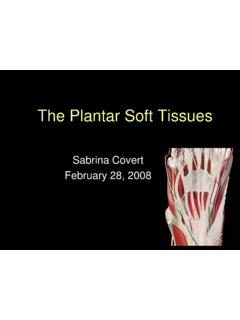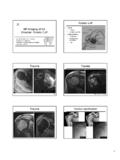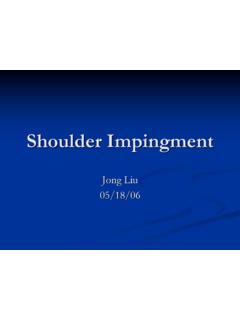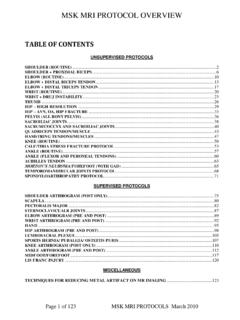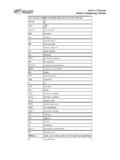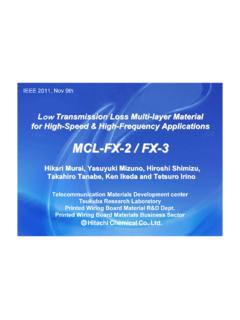Transcription of The Metatarsophalangeal Joints (MR Anatomy and …
1 The Metatarsophalangeal Joints (MR Anatomy and Pathology) Anatomy OF THE GREAT TOE MTP joint Articular Anatomy - Metatarsophalangeal -Metatarsoses amoid (tibial, fibular)Capsuloligamentous complex Fibrous capsule Redundant; attachments to MT head/neck junction, proximal phalangeal base Collateral ligamentous complex (CLC) Main collateral ligaments (medial, lateral): MT head -> base proximal phalanx Sesamoid-metatarsal ligaments (medial, lateral); aka sesamoid ligaments Common proximal attachment (depressions in sides of MT head) Sesamoid-phalangeal ligaments (medial, lateral) Intersesamoid ligament Plantar plate Fibrocartilagenous structure at the plantar aspect of the 1stMTP joint Proximally, blends with intersesamoid ligament, fibrous capsule Distal attachment is plantar aspect proximal phalangeal base Extensor hood (sagittal band) Extends from common extensor tendons to peripheral aspects of both sesamoidsAdditional supporting structures Flexor hallucis brevis tendons (medial, lateral heads) Origin: cuboid, lateral cuneiform Insertion.
2 Medial, lateral sesamoids Adductor hallucis tendon (transverse, oblique heads) Transverse head originates from capsules of 2nd-5thMTP Joints , deep transverse lig Oblique head originates from 2nd-4thMT bases, long plantar ligament Insertion: Lateral aspect of lateral sesamoid, lateral/plantar aspect proximal phalanx, (blends with the joint capsule) Abductor hallucis tendon Origin: medial aspect of the calcaneal tuberosity Insertion: medial aspect of medial sesamoid, medial/plantar aspect of proximal phalanx (blends with joint capsule) Flexor hallucis longus tendon Runs between sesamoids in the groove formed by the intersesamoid ligament/plantar capsular tissue; inserts on the plantar aspect of the distal phalanx Extensor hallucis brevis, longus tendons EHB inserts on dorsal aspect of proximal phalanx EHL inserts on dorsal aspect of distal phalanxFirst MTP joint structures (coronal plane) 1 cm proximal to the sesamoid bonesFirst MTP joint structures at the level of the sesamoid bones First MTP joint at the level of the proximal phalangeal baseFirst MTP joint structures in the transverse plane at the level of the sesamoid bonesExtensor Hallucis LongusExtensor Hallucis BrevisFlexor Hallucis BrevisFlexor Hallucis LongusJ Comput Assist Tomogr, Vol.
3 26, No. 5, 2002 Distal recess of plantar plateEHLJ oint capsuleFHLJ Comput Assist Tomogr, Vol. 26, No. 5, 2002 Sesamoid-phalangeal ligamentMT-sesamoidligamentFHB insertionAbductorhallucisAdductorhalluci sFlexor hallucis brevis (medial & lateral heads)FHLI nter-MT bursaLateral sesamoid-MTligamentAdductor hallucisFHLI ntersesamoidLigament/plantar plateEHLEHBJ Comput Assist Tomogr, Vol. 26, No. 5, 2002J Comput Assist Tomogr, Vol. 26, No. 5, 2002 Adductor HallucisAbductor HallucisLateral main collateral ligamentBursaJ Comput Assist Tomogr, Vol. 26, No. 5, 2002 EHLEHBA bductor HallucisFHLA dductor HallucisDeep transverse metatarsal ligamentAdductor Hallucis (transverse head)J Comput Assist Tomogr, Vol.
4 26, No. 5, 2002 Extensor hood (sagittal band)EHL, EHBbursaAdductor hallucisAbductor hallucisFHLJ Comput Assist Tomogr, Vol. 26, No. 5, 2002 Adductor hallucisLateral sesamoid MT ligamentAbductor hallucisIntersesamoid ligament/ plantar plateFHLEHLS agittal bandLateral sesamoid-MT ligamentAdd hallucisFHLIS ligament/plantar plateAbd hallucisJ Comput Assist Tomogr, Vol. 26, No. 5, 2002 Abductor hallucisAdductor hallucisFHLJ Comput Assist Tomogr, Vol. 26, No. 5, 2002 Anatomy OF THE LESSER MTP Joints Capsuloligamentous complex Fibrous capsule Collateral ligamentous complex Main collateral ligaments (attach to sides of phalangeal base) Accessory collateral ligaments (attach to sides of plantar plate)
5 Common proximal attachment to dorsal tubercle of MT heads Plantar plate Fibrocartilagenous structure at plantar aspect of joint runs between metatarsal head, proximal phalanxAdditional structures Flexor digitorum longus and brevis Extensor digitorum longus and brevis Extensor expansion/hood Flexor digiti minimi brevis Abductor digiti minimi Interosseous muscles Lumbricals Deep transverse metatarsal ligament Superficial transverse metatarsal ligament Neurovascular bundlesCLC = collateral ligamentous complexD, P = dorsal or plantar interosseous muscles (origin on sides or inferior surf MTs, insert base proximal phalanx, extensor hood) FdmB = flexor digiti minimi brevisO=oblique head adductor hallucisT=transverse head adductor hallucisRadiology 227 (1), 2003 EHL EHB EDL EDBE xtensor hoodJoint capsuleAbductor hallucisFHLDeep transverse MT ligament (connectsplantar plates)NV bundleSuperficial transverse MT ligamentAbductor digitiminimiFlexor digiti minimi brevisPl fasciaFDL, FDBLFDLR adiology 227 (1), 2003 Capsular attachmentCapsular-plantar plate attachmentPlantar platePlantar plate recessRadiology 227 (1), 2003 Extensor hoodFibrous capsuleInterosseous tendonCLCP lantar plateRadiology 227 (1), 2003 Main collateral ligament Interosseous tendonbursaRadiology 227 (1)
6 , 2003 Plantar plateDistal plantar plate insertionProximal (MT) plantar plate-capsule insertionCapsule attachmentBare area of proximal phalanxRadiology 227 (1), 2003 MTP joint PATHOLOGYMR protocol Dedicated extremity coil Triplanar nonfat suppressed PD for Anatomy Triplanar PD FS or STIR for acute pathology PD FS has better resolution, anatomic detail STIR preferred if homogenous fat suppression cannot be obtained secondary to field inhomogeneity FOV 10-14 cm 3 mm slice thicknessPainful conditions affecting the MTP Joints Trauma Degenerative Arthritis Infection Osteonecrosis Neoplastic /non-neoplastic masses Sesamoid dysfunctionTrauma Capsuloligamentous injury Turf toe Skimboarder s toe Acute fracture Stress fracture Fatigue InsufficencyTURF TOE Sprain of the plantar capsuloligamentous complex of the great toe MTP joint #1 mechanism is hyperextension Called turf toe after advent of artificial playing surfaces in late 1960 s led to increased use of flexible footwear with less plantar support MC in athletes
7 Who participate in cutting or pivoting sports, especially footballCapsuloligamentous complex: Plantar plate fibrous capsule collateral ligamentouscomplex main collateral ligaments sesamoid-MT ligaments sesamoid-phalangealligaments intersesamoid ligamentSpectrum of injury also encompasses: Osseous/osteochondralinjury: sesamoid injury(fx, diastasis, diastasis of bipartitie sesamoid) 1stMT fx, chondral injury FHB, abd/add hallucis strainFootball injury: Complete tear of medial sesamoid phalangeal ligament with proximal retraction of the medial sesamoid, FHB strainNORMAL ANATOMYS esamoid-phalangeal ligamentMT-sesamoidligamentFHB insertionFootball injury: Bilateral sesamoid phalangeal ligament tears with edema, hemorrhage; plantar plate is outlined by edema and hemorhage deep to FHL.
8 NORMAL ANATOMYSPSPFHLCRISTAF ootball injury: Distal metatarsosesamoid ligament tear, FHB strain; intact sesamoid phalangeal ligamentIntersesamoid ligament rupture with sesamoid diastasisAbductor hallucisAdductorhallucisIntersesamoid ligamentFHLC omplete tear of MCL and partial tear of LCLN ormal MCL, LCL (main collateral ligaments)FHB medial head strain AbductorhallucisAdductorhallucisFlexor hallucis brevis (medial & lateral heads)FHLC apsular and tendinous avulsion from the medial margin of the medial sesamoid with periosteal stripping (subacute injury)51-year-old man with recent injury of left great toeTurf toe with diastasis of fractured sesamoidsBipartitie sesamoid diastasisNormal plantar plate for comparison Turf toe injury in a 24-year-old professional football player: disruption of plantar plate with associated edema and osteochondral injury1stMT headDisrupted plantar plate at the 2ndMTP joint in a 48-year-old woman who presented with foot pain (no history of injury)Classification of injury Grade I: sprain of the plantar capsular complex with pain, tenderness, swelling Grade II: capsular disruption with bruising, decreased ROM Grade III: Chronic injury.
9 Results in decreased ROM, OATreatment Low grade injury usually treated conservatively High consideration for surgery if: Extensive capsular tearing with instability Sesamoid fx Significant sesamoid retration Sesamoid diastasis Osteochondral lesions Intra-articular bodies High level athletes Goal of surgery = repair and restore anatomyPreoperative exam: proximal rupture of the sesamoid phalangeal ligamentPost-operative examination showing primary repair of the sesamoid phalangeal ligamentComplications/sequelae Chondromalacia of 1stMT head Osteoarthritis 1stMTP Hallux valgus Hallux rigidus (dorsal osteophytosis)SKIMBOARDER S TOE Skimboarding is a beachside sport in which the athlete stands on the shore, drops the board on the ground, and jumps on it in very shallow water Skimboarder s toe = hyperdorsiflexion injury of the MTP Joints Unlike in turf toe, the injured capsuloligamentous structures are dorsal, rather than plantarMECHANISM: Skimboarder uses toes to grip board.
10 If board slips posteriorly in relation to skimboarder, hyperdorsiflexion at the MTP Joints may occur If the toe is violently hyperextended, forces apply to the EHL/EDL in a dorsal direction, potentially disrupting the extensor expansion May be a/w avulsion fx proximal phalanx Theory as to why anatomic distribution of injury differs from turf toe despite similar mechanism: skimboarding is done barefoot, rendering extensor longus tendons more apt to dorsiflex and tear the extensor expansion39-year-old skimboarder s/p hyperextension injury of 1stMTP joint :-dorsal soft tissue swelling-disruption of dorsal aspect of extensor expansion-intact extensor tendons-intact plantar plateHyperextension injury of the 2ndMTP:-dorsal soft tissue swelling-lax/wavy, discontinuous extensor hood-marrow edema proximal phalanx-normal plantar plateMetatarsal fracture Acute fx Stress fx Fatigue Runners, military recruits, gymnasts Especially mid-distal 2nd-4thMTs InsufficiencyMetatarsal stress fractureInsufficiency fracture of 2ndMT headInsufficiency fracture of 2ndMT headInsufficiency fracture of 2ndMT headFreiberg s infraction MC in adolescents, young women MC in 2ndMT head Cause is controversial, likely multifactorial Popular theory.
